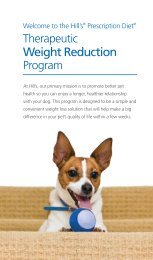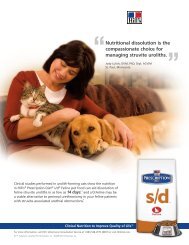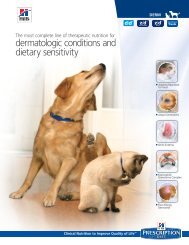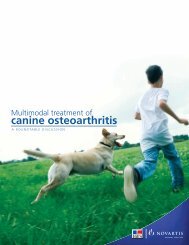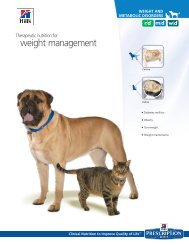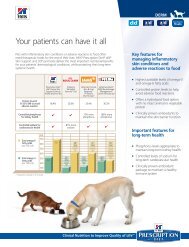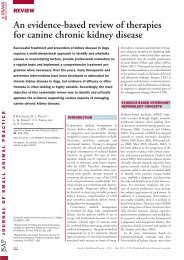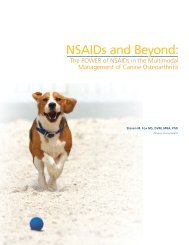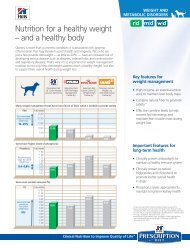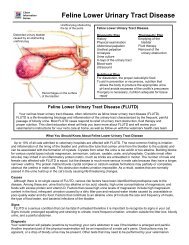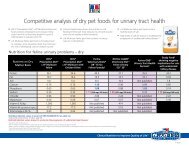using nutrition to ease the pain of osteoarthritis - HillsVet
using nutrition to ease the pain of osteoarthritis - HillsVet
using nutrition to ease the pain of osteoarthritis - HillsVet
Create successful ePaper yourself
Turn your PDF publications into a flip-book with our unique Google optimized e-Paper software.
<strong>nutrition</strong> myths and truths, facts and fallacies<br />
Clinical Case:<br />
Nutritional management <strong>of</strong> <strong>osteoarthritis</strong><br />
Phoebe<br />
His<strong>to</strong>ry and clinical findings<br />
Phoebe, a 6-year-old neutered female Labrador retriever mix, was<br />
examined for rear limb lameness <strong>of</strong> two years duration. Clinical signs<br />
were mild <strong>to</strong> moderate in severity and included difficulty in rising<br />
from rest, limping, stiffness and reluctance <strong>to</strong> run, jump or play. No<br />
medications or supplements were being given by <strong>the</strong> owner. Phoebe<br />
weighed 75 pounds but was considered overweight with a body<br />
condition score <strong>of</strong> 4 on a 5-point scale. Phoebe was fed a low-calorie<br />
dry dog food but had access <strong>to</strong> o<strong>the</strong>r food sources for cats and dogs in<br />
<strong>the</strong> same household.<br />
Physical examination was normal except for <strong>the</strong> overweight body condition and orthopedic problems. A thorough<br />
orthopedic examination revealed <strong>the</strong> following abnormalities:<br />
✔ slight lameness at a walk<br />
✔ normal weight-bearing at rest but favors <strong>the</strong> left rear limb when walking<br />
✔ mild limitation in range <strong>of</strong> motion <strong>of</strong> <strong>the</strong> left hip joint<br />
✔ <strong>of</strong>fers mild resistance when <strong>the</strong> right rear limb is elevated but bears full weight on <strong>the</strong> left hind limb<br />
✔ mild <strong>pain</strong> is elicited upon palpation <strong>of</strong> <strong>the</strong> left hip joint.<br />
A complete blood count, serum biochemistry pr<strong>of</strong>ile and<br />
urinalysis were normal. Radiographs showed changes consistent<br />
with bilateral hip dysplasia and degenerative joint dis<strong>ease</strong> with<br />
<strong>the</strong> left cox<strong>of</strong>emoral joint more severely affected (Fig. 1).<br />
Questions<br />
Q. What are <strong>the</strong> <strong>the</strong>rapeutic goals for managing patients with<br />
<strong>osteoarthritis</strong> or degenerative joint dis<strong>ease</strong> <strong>of</strong> hip joints?<br />
A. Therapeutic goals for managing chronic <strong>osteoarthritis</strong> or<br />
degenerative joint dis<strong>ease</strong> in <strong>the</strong> cox<strong>of</strong>emoral joints include:<br />
✔ Eliminating underlying causes (e.g., femoral head and<br />
neck excision for aseptic necrosis <strong>of</strong> <strong>the</strong> femoral head)<br />
Figure 1: Radiographs consistent with<br />
bilateral hip dysplasia and degenerative<br />
joint dis<strong>ease</strong> with <strong>the</strong> left cox<strong>of</strong>emoral joint<br />
more severely affected.<br />
✔ Setting realistic treatment expectations with Phoebe’s<br />
owner<br />
✔ Enhancing Phoebe’s quality <strong>of</strong> life by reducing <strong>pain</strong>,<br />
maintaining or improving activity level and improving<br />
joint function<br />
✔ Slowing dis<strong>ease</strong> progression by modifying cartilage<br />
structure and function.



